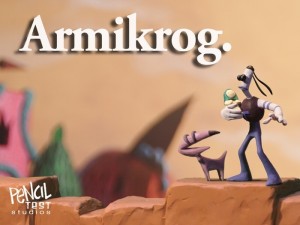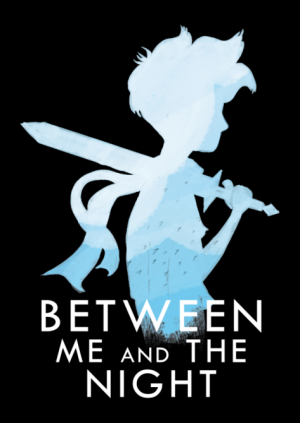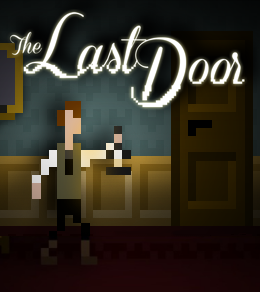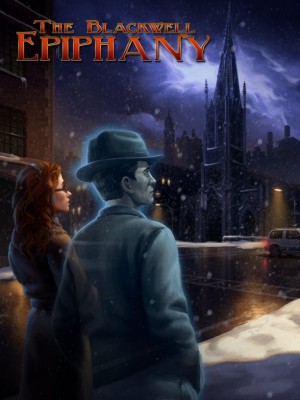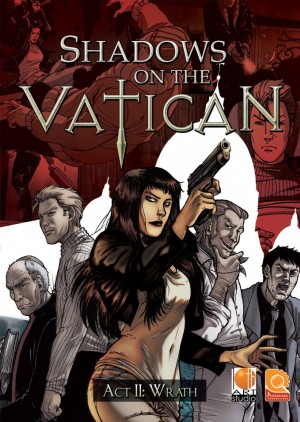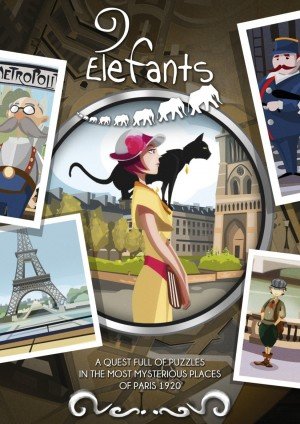EGX Rezzed 2015 round-up page 3
Events Coverage
Reporting from E3, GDC, AdventureX, Gamescom and other gaming events around the world

Spanning two levels of the sprawling Tobacco Docks exhibition site in central London, EGX Rezzed was a celebration of electronic gaming. A wide range of experiences were available to suit all palates, with some unusual offerings on display. At a stand decked out to match its game setting, players were challenged to get the fastest time driving a bagel around a virtual kitchen. The zombie apocalypse got a new twist, with the undead being mowed down by sloths with swords and elephants with machine guns. One developer appeared to confuse the “virtual” part of Virtual Reality, offering players the Oculus Rift experience of being shut in a coffin whilst actually shut in a coffin. Another demonstrated a new control system, with a game controlled by your breathing. Co-operative gaming took a new turn, with one player viewing a fantasy world on a tablet directing another player with a phone whose motion controlled the protagonist of that world. There was even a truly minimalist offering, with a dungeon crawler where the dungeon consisted of a single line of LED lights.
Into this maelstrom I went in search of adventuring goodness. This is what I found.
Armikrog
Tommynaut, brave explorer of the universe, is having a bad day. He and his blind alien dog sidekick, Beak-Beak, have crash-landed on a hostile planet. Having narrowly escaped being eaten by the local wildlife, the intrepid pair seek shelter in a nearby building. Little do they know that this is the fabled fortress of Armikrog, and many strange and wondrous revelations await them inside.
It has been nearly 19 years since The Neverhood was first released on PC. Rather than a sequel, the cult classic claymation adventure is to get a spiritual successor in the form of Armikrog, with two of the artists from its predecessor, Ed Schofield and Mike Dietz, and writer/artist Doug TenNapel reuniting once more. The look is reminiscent of the earlier game, with stop-motion animation once again being used. Tommynaut is a humanoid character, though with grey skin and bulging black eyes. He clearly sees himself as a great hero, taking big strides and often adopting a hands-on-hips stance. His companion, dog-like but with a sharp pointed nose and two ridges where his eyes should be, is much more excitable. Both have been voiced by professional actors, and the quality of the sound recording came through. Tongue-in-cheek humour was central to the script, especially with the somewhat acerbic put-downs of Beak-Beak.
The demo on display consisted of the opening rooms of the tower, the scenery including high-vaulted rooms, some sporting vast machine parts, and some peculiar alien wildlife. The makers boast that there are no simple decorations in the game, with all markings and objects having a purpose. For some, these are simply to provide more life, such as the activities of the local fauna as viewed through a window. Sam Forrest, from the game’s publisher Versus Evil, was keen to ensure I saw that this was not just a one-off. Clicking this window repeatedly produced a series of animations. Given how time-consuming the animation method is, and that many players would not consider clicking more than once, I found this a surprisingly pleasing attention to detail. Recorded at 30 frames per minute, the animation overall is nothing short of amazing. I have seen too many games have a character just vaguely wave their hand at objects to pick them up. No such shortcuts are taken here, and the gestures for even picking up an item are so grandiose they are a joy to watch.
 |
Versus Evil's Sam Forrest |
Inventory is handled automatically, with Tommynaut literally placing objects within his chest for later retrieval. It is also possible to temporarily take control of Beak-Beak to access areas too small for Tommynaut. When in an area only occupied by Beak-Beak, the graphics change to a slightly blurry black-and-white appearance, representing his blinded sense of his surroundings. This also revealed extra detail in one location, so it would appear Beak-Beak’s non-visual sense can “see” things Tommynaut can’t.
By the time I’d finished the demo I’d gained part of a code, called a tentacle to operate as a lift, and seen some surreal but funny animal antics. Just this brief try, covering less than half a dozen rooms, certainly left me eager for more. The creators are definitely not just relying on nostalgia for The Neverhood, and I look forward to seeing the finished product.
With the game on track for release sometime this spring, you can find more information about Armikrog at the official website.
Blues and Bullets
Eliot Ness is the American Prohibition agent who achieved fame bringing down the gangster Al Capone. In this new episodic game from A Crowd of Monsters, Ness has subsequently retired to run the titular Blues and Bullets diner in the town of Santa Esperanza. The place is a favourite haunt of cops, eager to regale the retired lawman with current tales of life on the force. Then one day a new face at the counter brings Ness’s past back to haunt him. Capone’s granddaughter has been kidnapped, and his former nemesis is the only man he trusts to get her back. Ness agrees, but with gruesome murders and gunplay to face, he may wish he’d stuck to serving pie.
The game’s graphics are a realistic representation in all but one aspect: everything is coloured in black and white with the exception of red items. The overall feel is very much of a gritty noir detective thriller. With murder being a key part of the action, this often means blood trails, though Ness’s tie and a sporty car also get coloured. The look is fully 3D, with high resolution and detailed facial expressions. Visitors were able to choose from four scenes to play in the demo. The first scene took place in the diner, where you served coffee and food to your loyal clientele. This is clearly intended to be the tutorial level for the game itself, involving simply moving around and a handful of simple actions. When conversations needed a response, these were presented as brief one- or two-word descriptors scattered around the protagonist, each associated with a particular controller button.
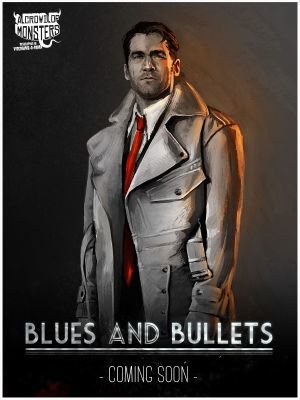 The other scene I played was a horrific murder scene. This was extremely graphic, ensuring that Blues and Bullets is not going to be a game for the young or squeamish. In this section it was necessary to walk around the crime scene looking for clues. Moving around caused areas to highlight as you approached them, with a button press zooming in for a closer look. Manipulating the camera in these close-up views allowed more precise details to be observed, with clues being pinned to a virtual incident board. A single button press provides access to this board, allowing you to link clues together, with the intention of getting more insight into the crime. As well as simply observing, I also discovered a room apparently secured from the inside, though I failed to work out how to gain access. One of the other scenes available involved a shoot-out, which will require some skill to pass, but I am assured that these are likely to only take up 10% of gameplay at most.
The other scene I played was a horrific murder scene. This was extremely graphic, ensuring that Blues and Bullets is not going to be a game for the young or squeamish. In this section it was necessary to walk around the crime scene looking for clues. Moving around caused areas to highlight as you approached them, with a button press zooming in for a closer look. Manipulating the camera in these close-up views allowed more precise details to be observed, with clues being pinned to a virtual incident board. A single button press provides access to this board, allowing you to link clues together, with the intention of getting more insight into the crime. As well as simply observing, I also discovered a room apparently secured from the inside, though I failed to work out how to gain access. One of the other scenes available involved a shoot-out, which will require some skill to pass, but I am assured that these are likely to only take up 10% of gameplay at most.
The set-up is definitely intriguing, with the opportunity to control such a legend of law enforcement most enticing. The graphics are beautifully rendered, really conveying the horror of the more shocking aspects of the murder scene. The dialogue I heard is extremely well-written and the delivery, especially Ness’s gravelly tones, is spot on.
The first episode of Blues and Bullets is due for release in May 2015, with five episodes planned in total. To learn more about the series, visit the developer’s website.
Beyond Eyes
For Beyond Eyes, developer tiger & squid have come up with a most unusual choice of protagonist. In this game you take on the role of Rae, a ten-year-old girl who was blinded in a fireworks accident whilst still a toddler. Since that time Rae has feared leaving her home, finding companionship with a big red cat she calls Nani. When her feline friend goes missing, however, Rae must overcome this fear and venture out in search of her. The result is a gentle game, but one that is both beautiful and full of wonder.
When I first started playing, the screen was largely white. The only clear thing on the screen was Rae herself, a young girl in a white dress and purple Wellingtons. The area immediately around Rae was grass, painted in a soft watercolour style. This vagueness artfully conveys the sense that the landscape is based on Rae’s limited memories of the world from before she lost her sight. As I commenced her journey into the wider world, Rae initially walked with her head down and arms crossed. The landscape slowly filled out as I explored, with ambient noise such as bird song and the wind blowing through leaves providing the background to the scenery. Finding a fence, I had to trace my way slowly along its length seeking a way through.
 |
Tiger & squid's Sherida Halatoe |
In the brief time I spent playing, I did not encounter any puzzle more challenging than crossing a stile. But this is clearly a game where simple blind exploration is the challenge, and one that proves surprisingly satisfying. The way the landscape revealed itself only where I walked made even the smallest steps display new wonders. A single peal on a bell in a tower brought a brief glimpse of the top of that tower, fading as Rae lost track of where the sound came from. The fact that the visible landscape is only Rae’s interpretation from her other senses was also cleverly handled. Walking towards a beautiful fountain caused it to fade away, revealing that the trickling noise that had created this impression actually came from a drainage pipe.
There is no firm release date for Beyond Eyes just yet, but it’s currently on track for completion sometime this year. You can follow the game's progress at the official website.
Toren
In Brazil, the games industry is still in its infancy, with tax breaks available for investing in game development. Swordtales, the developer of Toren, are one of the first companies to benefit from this initiative. They have used this support to put together a fantastical adventure steeped in Brazilian mythology. With heavy use of symbolism and death being a vital part of gameplay, the results so far look intriguing.
The protagonist of the adventure is a young girl known only as Moonchild. She grows up over the course of the game, starting as only a small toddler in the opening tutorial part of the demo. Moonchild lives alone in the forbidden tower of Toren. This is a crumbling edifice, a vast stone tower overrun with creepers and other plant life. In her quest to ascend the tower, Moonchild is guided by a spirit mentor, whose tall humanoid desiccated husk sits on a throne at the base of the tower. An early task is to plant a tiny sapling, the tree of life, in the centre of the tower. Over the course of the game this tree grows, with Moonchild’s aid, often providing access to higher levels as it does so. I was told that early playtesters have compared Toren’s gameplay to the non-combat puzzles of the Tomb Raider series, where exploration and manipulation of ruins is required to progress. From the brief bit of dragging and climbing I undertook, along with the overall look of the game, I can see where that comparison comes from.
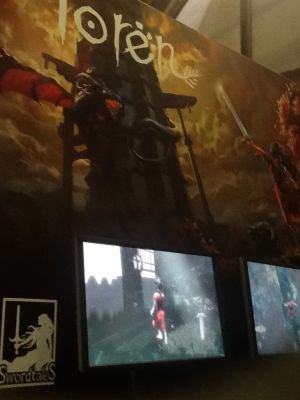 |
Toren on display at EGX Rezzed |
Whilst Moonchild has no living companion, she does have an adversary. A green-eyed dragon lurks at the top of the tower, and descends on occasion to hamper the child’s progress. This creature can put forth a wave of black shadow which, if it touches her, can transform Moonchild to stone. This transfers Moonchild into a dream world, rife with symbolism, where she can learn more to aid her in the physical realm. Transferring back to the real world reincarnates Moonchild, with the statue from her previous life now a permanent fixture there. These prove vital to progress in some areas. Crossing a wide ledge, you may find it impossible to reach the far side before falling prey to the dragon’s power. On returning to the same area, however, that statue of Moonchild now provides the necessary shelter from the shadow to reach the other side. Another provides a stepping stone to access something previously too high to reach.
It was hard to get a proper feel for the game from a short demonstration, but with the demo showing different sections of the game, there were enough interesting elements presented to catch my attention. The enigma of a young girl living alone apart from her draconic nemesis is one I would be keen to resolve, and the gameplay I did see makes me think it could be an interesting journey.
In keeping with its new life theme, Toren itself should emerge sometime this spring. While you wait, you can find more information at the game’s website.
Aviary Attorney
When something proves successful, it is often the subject of cheap imitation as others rush to cash in on that success. At first glance, Aviary Attorney might appear to be guilty of this, with its look, gameplay and even name clearly inspired by the Ace Attorney series. But even the brief demo on offer made it clear that this is not a game simply riding on the coattails of others. Instead, Sketchy Logic Games’ Jeremy Noghani and Mandy Lennon presented me with an amusing experience that definitely left me wanting to see more.
The graphic style is somewhat unusual. In looking to create a unique aesthetic for their game, the designers have drawn on the illustrations of 19th Century French satirist J.J. Grandville. His most well-known work involved anthropomorphic animals garbed in costumes of the day and engaged in human activities. Selecting illustrations from these, the developers have come up with Monsieur Jayjay Falcon, 19th century aviary defence attorney and his assistant Sparrowson. Other characters come from different parts of the animal kingdom, with the first victim being a frog, Monsieur Grenwee, and the incompetent prosecutor of the tutorial case in the demo being the timid Rupert Rabbington. The characters have been set against background illustrations of the same era, with use of layering to create a 2D effect from the 3D drawings. The developers told me that finding backgrounds to both match the characters and illustrate the desired locations has been difficult at times. But from what I’ve seen, I can only say that the effort has paid off well.
 |
Sketchy Logic's Jeremy Noghani and Mandy Lennon |
The case presented in the demo appeared to be cut-and-dried, with a feline defendant, Lady Caterline, found standing over the victim with bloody paws. By the end of the demo, I had at least cast doubt on her guilt, using a most peculiar piece of evidence to do so. This had been gathered from an interview with a lion that both the accused and victim had been dining with that evening. The opportunity to present evidence came up in cross-examination of the police inspector assigned to the case. I also paid a visit to a photographer’s studio, my search for evidence there involving some actions of dubious legality. This trip appeared optional, and I was told that evidence can be missed and even cases lost without bringing the game to an abrupt end.
The personalities of the characters came through from the start, especially Sparrowson, who is less of a wit than he seems to think. Apart from Sparrowson’s obvious puns, the humour of the script showed a clever subtlety that bodes well for the completed game. Like the Ace Attorney series, this game is not voiced, but a soundtrack of music contemporary to the pictures formed a suitable background.
The current plan is for Aviary Attorney to be released for PC and Mac in June, with the hope of transferring it to mobile devices later. You can learn more about the game on the official website.
Rok
Drawing on mythology doesn’t mean a game has to be set in a fantasy world or the past. Whilst clearly taking their cue from Norse mythology, Stitch Games’ new production Rok is firmly placed in a sci-fi setting. An old bearded man is chained in a tiny cubicle, drained of almost all his energy. From nowhere a female voice calls to him, using powers beyond those of man to free him from his cell. Granted a fraction of that power, the man must now make his way out of the prison that holds him. But the Valkyries are not keen to see him escape, and will do all they can to stop him.
Rok’s 3D presentation makes the deliberate choice to use a low-polygon count. This gives the game a retro look reminiscent of mid- to late-1990s third-person shooters. The opening scenes involve transporting the unnamed protagonist’s cylindrical cell up a lift shaft. The cell stops at each level, introducing more of the game mechanics. This game has been designed for tablet devices, and makes full use of the various gestures available. Represented as telekinetic powers, the player’s gestures manipulate the environment. An abrupt swipe rips delicate components from walls. A more gentle hold and slide movement is used to activate levers or move items from place to place. Tougher items require pressing and holding to build up power before doing anything. Finally, a simple tap activates buttons. This action also directs the player character, with a double-tap making him run.
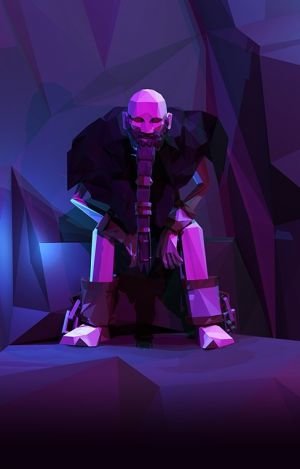 Once past the opening section, the main character is able to move freely. Up to this point the things you can interact with have been fairly obvious. From here on in you have to not only work out what items you can affect, but how. If stuck, a button in the top-right of the screen highlights interactive areas as long as it is held. You will need to get more creative as you go, moving platforms around to create new pathways and timing a dash past some security measures. There are also occasions where moving slowly is the best way of avoiding security measures. At certain points, robotic Valkyrie guards will fly in to accost you. You must sweep these away before they can harm you, though such contact simply restarts the section in which a squad of guards first starts attacking.
Once past the opening section, the main character is able to move freely. Up to this point the things you can interact with have been fairly obvious. From here on in you have to not only work out what items you can affect, but how. If stuck, a button in the top-right of the screen highlights interactive areas as long as it is held. You will need to get more creative as you go, moving platforms around to create new pathways and timing a dash past some security measures. There are also occasions where moving slowly is the best way of avoiding security measures. At certain points, robotic Valkyrie guards will fly in to accost you. You must sweep these away before they can harm you, though such contact simply restarts the section in which a squad of guards first starts attacking.
Though the part of the demo I played didn’t go very far in revealing much about the main character, the developers promise that his full story will be disclosed over the course of the game. Even with the addition of more physical control elements than adventurers are probably used to, the game presents solid puzzles that will appeal to many gamers. There is also something inherently satisfying with achieving effects well beyond the character’s reach. There’s nothing quite like inflicting wanton destruction or hurling aside foes at the flick of a finger to make you feel all-powerful.
There isn’t too much longer to wait for Rok, as the game is on track for release sometime this spring. In the meantime, tablet users can find more information on the game’s website.
Between Me and the Night
Described as a study in duality, RainDance LX's Between Me and the Night almost plays like two games in one. The first game is the Day setting. In this the protagonist, an unnamed red-haired boy, walks around an ordinary house. At the start the only room accessible is his attic bedroom. This is sparsely furnished, apart from a collection of toys and comics scattered around it. Solving puzzles in this mode gives access to further rooms in the house, revealing more about the character. Whilst this section is ostensibly the real world, fantasy elements creep in, casting doubt on the lead character’s sanity. Two ghost children sat in front of the television at the beginning, though they vanished when I joined them. Later, having solved a few puzzles, the television surprised me by getting up and walking away.
When the boy goes to sleep you enter the Night setting. At this point you take on the role of a knight on a great quest. The worlds in this setting are to be procedurally generated, and solving puzzles in the waking world makes the dream world knight stronger, able to take and deal more damage to pass the obstacles in his path. In the part I played, the Night environment consisted of a barren rocky path enveloped in a gentle snowstorm. Whilst the Day setting has clear detail, the graphics at Night have a softer look to them, giving them an ethereal quality. Here you must combat fantasy monsters as well as making use of magic and avoiding traps. When you take too much damage in this section, you are thrown out of this dream world back into the waking setting. The combat and traps I faced did require a modicum of action ability, but they were not particularly onerous.
 |
RainDance's João Ortega and Karlos Garcia |
With the fantasy world apparently representing half of the game, this probably won’t be a game for the adventure purist. But the section played in the real world did feel very much like a traditional adventure. Real effort has gone into not making it a sterile environment either, with many of the toys and other background items interactive. I was only able to play the opening portion of the child section, but developers João Ortega and Karlos Garcia told me the real world is supposed to span three ages: child, teenager and adult. The game is currently in pre-alpha stage, with hope of final release in about four months.
Further news of development on Between Me and the Night can be found on the official website.
Closing Thoughts
Whilst adventures were definitely in the minority at this videogame convention, there were some interesting titles on show. Many of these were from small indie developers, with teams of even just one or two people producing quality products. For some there is still work to be done before they’re finished, but the demos I saw and played definitely whetted my appetite. Having sampled them in part, I eagerly await the full releases.



